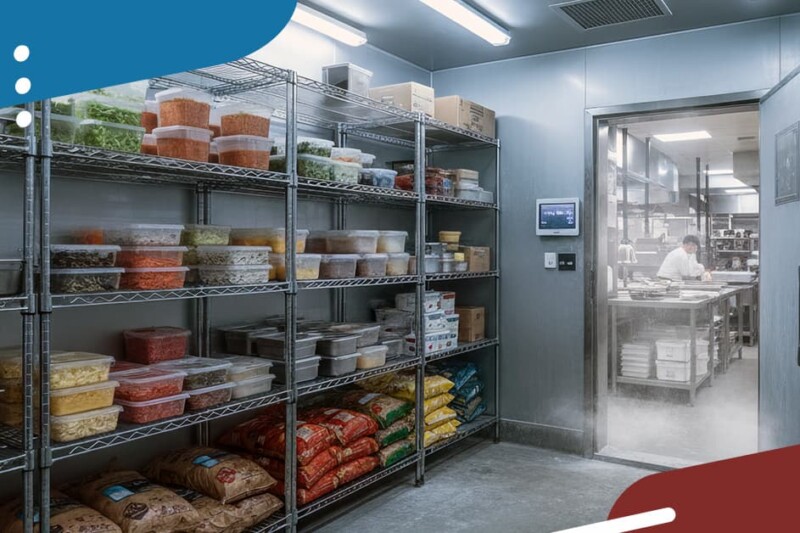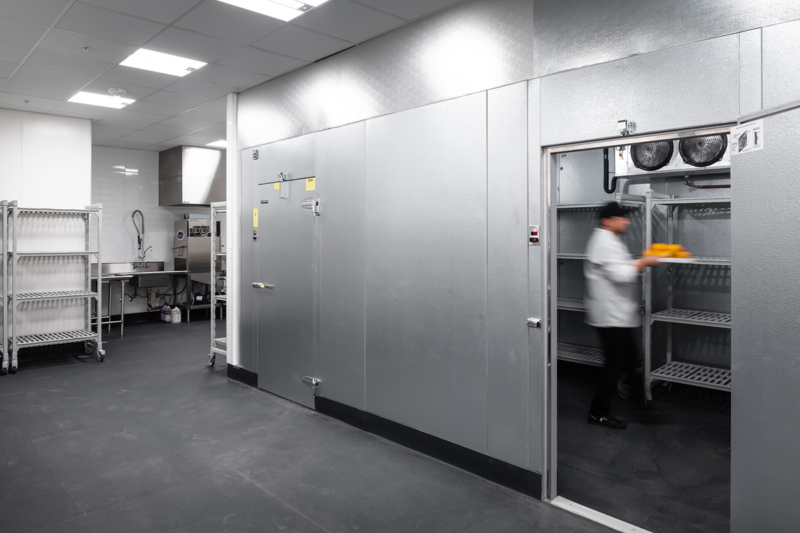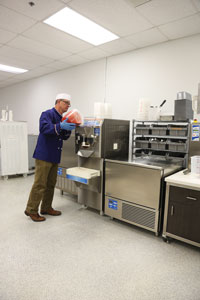
These days, it seems all you have to do is blink and a new line of gelato will magically appear on a restaurant menu down the street or in your local grocer’s freezer case. Often touted as “home-made” or “artisan”—even from major consumer-brand companies—these frozen treats come in flavor combinations that customers clamor for, especially millennials.
But just what is gelato, and how can you get in on the craze? Gelato, quite simply, is Italian-style ice cream. Unlike traditional hard ice cream, however, gelato has less fat, more sugar, and is held at higher temperatures, all of which give it a softer, smoother texture and creamy mouthfeel. Getting in on the trend is as easy as making it yourself. It all starts with a batch freezer.
A good batch freezer can turn out not only any kind of gelato you can dream up, but also a wide range of other frozen treats from granita or Italian ice made with juices or water and flavoring ingredients to sorbet (flavored ices made with fruit or vegetable juices or purees but sometimes made from ingredients such as cocoa, coffee, etc.), sherbet (fruit-flavored ices with 1%-2% butterfat), low-fat ice cream (at least 3.5% butterfat), premium ice cream (with a minimum of 10% butterfat), and frozen custard (made with at least 10% butterfat, often from cream, and at least 1.4% egg yolks).
Buying a batch freezer, in other words, can help you turn out terrific gelato, and potentially expand your dessert menu to rival that of any ice cream shop.
Sizing Up Your Opportunity
Equipment manufacturers design and build batch freezers in a large number of sizes with production capacities ranging from about 1 qt. per hour to 30 or more gal. per hour. As you might expect, small models fit on the countertop, and large models stand on the floor, but you can get many middle-range models in either countertop or floor models (though not necessarily from the same manufacturer).
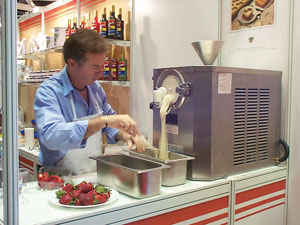 Smaller models, both countertop and floor, typically have self-contained, air-cooled refrigeration systems. Larger models often are water cooled, and may be self-contained or remote. Again, medium capacity machines may give you a choice between air-cooled and water-cooled models. One thing to note on air-cooled machines, especially countertop units, is how much clearance they need for air circulation. At a minimum, machines require 3 in. or more of clearance on all venting sides; at least one model needs 20 in. of clearance in back.
Smaller models, both countertop and floor, typically have self-contained, air-cooled refrigeration systems. Larger models often are water cooled, and may be self-contained or remote. Again, medium capacity machines may give you a choice between air-cooled and water-cooled models. One thing to note on air-cooled machines, especially countertop units, is how much clearance they need for air circulation. At a minimum, machines require 3 in. or more of clearance on all venting sides; at least one model needs 20 in. of clearance in back.
A quick note: since many brands are imported from Italy (and gelato is an Italian tradition), you’ll see a lot of capacities listed in liters. A liter is the equivalent of 1.05669 qt. Since we’re more familiar with English measurements in quarts and gallons, capacities listed here and in the accompanying informational chart (page 32) are sometimes approximate conversions.
Traditional “gelaterias” or gelato shops produce batches designed to fill 5-liter pans (about 5.3 qt. or 1.3 gal.). Some batch freezers are capable of producing half batches, which amounts to half the machine’s capacity, not necessarily 2.5 liters. Gelato makers place batches into a blast chiller/ freezer to form a hard shell on the top and then transfer them to a display case for holding and serving. Cases may hold dozens of flavors, and the shops typically make fresh batches two or three times a day depending on how fast each flavor moves. (See accompanying articles, “Showing Off Gelato,” page 44, and “Why Buy A Blast Chiller?,” page 51.)
Base the size of the machine you need on how many flavors you plan to offer, how many servings of each you plan to sell daily, and most importantly, how many servings you’ll sell per hour during peak rush times in your operation. If you think you’ll sell 60 4-oz. servings per hour during a busy two-hour lunch rush, for example, you’ll need a machine capable of producing 15 qt. per hour. (Even if you already have some pre-made on hand, better to have overcapacity than not enough.) The time it takes to freeze each batch depends on the product (ice cream could take less time to make than Italian ice), and the unit itself.
Down To Basics
If you already use a slushy machine for frozen beverages or bar drinks or a soft-serve ice cream machine, you know how a batch freezer works. The primary difference is that these two machines make product on a continuous basis, whereas a batch freezer, as the name implies, makes product a single batch at a time.
The innards, though, are much the same. Product goes into a freezing cylinder, a stainless cylinder surrounded by the evaporator coil of a refrigeration unit. A rotating shaft with arms in the center of the cylinder stirs the liquid content so it comes into contact with the sub-freezing cylinder walls, and blades attached to the shaft’s arms continuously scrape frozen product off the cylinder walls, mixing it into the product and allowing more product to come into contact with the freezing cylinder.
Freezing cylinders are oriented horizontally or vertically, depending on the model. Horizontal cylinders are more common than vertical, but makers of vertically mounted cylinders say they offer advantages. Vertical models often have a clear cover on top so you can see what’s happening in the freezing cylinder. Since they’re gravity-fed and not reliant on a design that pushes ingredients to the extraction chute on the front of the machine, makers say they’re easier to clean. Horizontal machines can give you the same power and capacity in a smaller footprint, sometimes letting you choose a countertop model instead of a floor unit.
Makers also say mix-ins, such as chocolate chips, fruit pieces, etc., are more thoroughly mixed throughout the product in a vertical cylinder. On a horizontal machine, mix-ins typically go into a chute that adds them to the finished product as it’s being extracted from the machine, which may result in a less consistent distribution.
Cylinders in machines with a similar capacity also may be different diameters. Manufacturers of machines with larger diameter cylinders claim the added dimension offers more freezing area, meaning less stirring or agitation to make a batch, resulting in a creamier consistency. And at least one maker claims that the thicker stainless walls of its cylinders freeze product faster and are more durable for hard mix-ins such as nuts and chips than others.
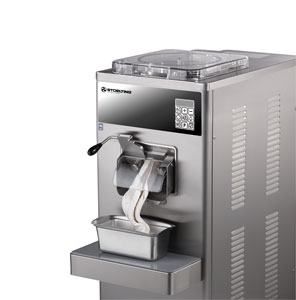 On Dasher, On Beater, On Auger, On…
On Dasher, On Beater, On Auger, On…
In the “a-rose-by-any-other-name” category, you’ll find that equipment makers refer to the rotating center shaft (with arms) of their machines by several different names. Most commonly referred to as a beater, agitator or dasher, it mixes product as the liquid freezes.
Agitators mounted in horizontal cylinders have gaskets or O-rings and must be well sealed to keep product from leaking into the motor, or oil from contaminating the product. As a result of their design, beaters in vertical cylinders don’t need gaskets.
As mentioned, blades attached to arms of the agitator scrape frozen product off the walls of the cylinder and mix it back in until the entire batch is frozen. Years ago, stainless blades dominated, but they created too much heat from friction against the cylinder wall, lengthening batch time and lowering the energy efficiency of the freezer. And all-stainless blades had to be sharpened and/or replaced often.
Most blades now are either NSF-certified plastic, or plastic-covered stainless. Both are spring-mounted to push the blade against the cylinder wall, but the covered stainless versions allow equipment makers to build a heavy blade that doesn’t require a lot of pressure to scrape the cylinder. Lighter, all-plastic blades require more pressure, and so tend to wear out faster.
Horsepower also will affect how easily a beater mixes your product. As product freezes, it generates more resistance to the agitator, requiring more torque to turn the shaft. A higher horsepower motor obviously can handle more torque with less effort. (Same with the separate compressor motor for the refrigeration unit, by the way—something to keep in mind as you set specs.)
‘S’a Lotta Gelata
Batch freezers range in sophistication from models with a simple on/off switch to units with touchscreen, programmable controls. Whether you’re planning on making small amounts of gelato in one or two flavors or churning out a variety of frozen desserts, the keys to all of them are time, temperature and torque (the consistency/thickness of the finished product).
The more control you have, the easier it is to make a variety of products. Some models add a timer to a basic on/ off switch so you can make batches of product by time. The timer may sound an alarm at the end of the time you set, turn the machine off, or both. Be sure to pick a model that best suits the needs of your kitchens.
Other models also include temperature controls, so you can set a finished product temperature to achieve the consistency you want. Gelato, for example, should be made and served between 10ÅãF-22ÅãF. Hard ice cream is usually made, stored and served at 0°F-5°F.
Programmable models not only let you manually set these parameters but also allow you to set and store product recipes so products turn out consistently every time. Most add control over the third factor affecting product quality—viscosity or consistency of the product itself. A sensor gets feedback from the beater shaft, measuring how much torque is required to mix the product, which tells the unit when the product has reached the desired consistency.
By doing some research and narrowing down what you need in production capacity, cylinder type, power and controls, you’ll be on the path toward the right batch freezer—plus potentially more profit.
Batch freezers can help you capitalize on the artisan gelato trend and make a variety of other profitable frozen sweet treats, too. Here, an employee at Toucan Charlie's Buffet & Grille, Atlantis Casino Resort Spa, Reno, Nev., scoops lemon gelato from an OTL ORION by Clabo USA display case. Inset: This Carpigiani unit produces gelato, granitas, sorbet and much more. Buttons sport simple, intuitive icons, and the display communicates production data.
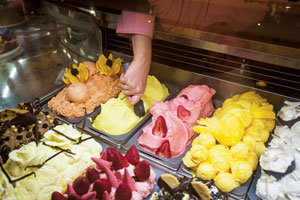 How Gelato Gets Its Texture
How Gelato Gets Its Texture
You’d think the higher percentage of butterfat in ice cream and frozen custard compared to gelato’s 7% or so (there are no USDA standards for gelato) would give them a creamier taste. Not so. One reason is temperature. Colder ice creams take longer to melt on the tongue and release flavor than warmer gelato. Butterfat, when it does melt, tends to coat the tongue, making it harder for taste buds to discern flavor.
Gelato’s creamy texture also often results from containing less of an unlabeled ingredient—air. As batch freezers mix frozen dessert products the beater stirs air into them. Called “overrun,” this added air can change the texture of the product. Think of the difference between a premium hard ice cream and soft-serve ice cream. They may have the same amount of butterfat, but soft-serve ice cream has a lot more air.
USDA rules allow up to 100% overrun in ice cream, meaning the end product can contain 50% air. A 5-qt. batch of liquid, in other words, turns into 10 qt. of ice cream (by volume—the USDA also says that finished ice cream must weigh no less than 4.5 lb. per gal.).
Gelato, on the other hand, typically has less overrun (about 20%-30%) than ice cream, giving it a dense, rich texture while still being lower in fat.
Keep It Clean
Many batch freezer makers claim their auger and extraction chute designs remove the maximum amount of finished product as possible at the end of a cycle. Regardless, all batch freezers will have some residue product inside after extracting a batch. In most cases, however, a simple rinse—running a bucket of warm water through the unit—will prevent flavor transfer from one batch to another.
If you make anything containing dairy, however, you’ll need to thoroughly clean and sanitize your batch freezer at the end of the day to meet local health code. It’s important to follow your manufacturer’s cleaning instructions to do it properly. Water and dairy products form mineral deposits on equipment called milk stone, which require special cleaning agents to remove.
Disassemble the machine, and take the beater/blade assembly apart. Most parts can be washed and sanitized in a dishmachine. Clean the inside of the unit according to the manufacturer’s instructions, using a recommended milk stone remover such as Stera-Sheen. Rinse as instructed, and reassemble the machine.
Many batch freezer models have a hose attachment that make rinsing the machine between batches easier. Several models made in Europe have an autoclean feature, and may also have a pasteurization cycle that lets you leave product in the machine overnight and reuse it the next day. Check with your local health department, though, to find out if that’s permitted where you operate.
BATCH FREEZER GALLERY
CARPIGIANI LB-502 RTX
Carpigiani’s LB-502 RTX batch freezer is fully automatic, featuring touchpad controls offering a greater range of batch sizes with precise control of product quality. The patented Hard-O-Dynamic system produces a consistent finished product regardless of batch size allowing operators to make large or small quantities of gelato, ice cream, sorbet, sherbet and more with consistent results. The LB-502 RTX offers the lowest power consumption in the industry, according to the company, while providing some of the quickest batch times. Cylinder is horizontally oriented.
carpigiani-usa.com
CATTABRIGA F-SERIES
Cattabriga’s F-Series of horizontal batch freezers range in capacity from 15 liters (3.96 gal.) for the F45, to 19 liters (5.01 gal.) for the F90, to 35 liters (9.24 gal.) for the F120. The fully automatic models come with electronic consistency control; plus, you have the flexibility of processing small and large quantities. The patented dasher system features narrow, steel beater bars, and replaceable plastic blades that allow you to efficiently produce varying types of product. (Because the beater bars are narrower, they take up less space in the cylinder, and you can add more product mix than if the paddles were wider.)
advancedgourmet.com
DONPER USA D750B
This user-friendly countertop batch freezer fits mid-volume applications. A singlehandle operation controls the dispensing door, making for easy use and access for cleaning. The product chute design maximizes flow and simplifies removal of product from the machine. Maintain product consistency with the easy-to-read Mix Flow Regulator, which adjusts the amount of mix flowing into the horizontal freezing cylinder. Built-in safety features include safeguards to prevent the machine from operating without a properly installed door.
donperusa.com
ELECTRO FREEZE B12
Electro Freeze batch freezers are designed to make a variety of frozen desserts from high-overrun hard ice cream to gelato, Italian ices, sorbets and sherbets. The medium-capacity B12 is designed to be mechanically simple and dependable. The exclusive auger and dispensing head design makes extraction easy, and adjustable torque control lets you manually adjust the torque to reach the desired product consistency; once the machine senses the amount of torque, it automatically shuts off the machine. The horizontal-cylinder-equipped unit features a cam door latch (a type of lock that quickly and easily creates a secure hold), built-in faucet with flex hose for cleaning, and a digital timer with audible alarm.
electrofreeze.com
EMERY THOMPSON CB-350
Emery Thompson’s countertop model CB-350 produces 6 liters (1.58 gal.) of gelato in under 9 min. With its exclusive Infinite Overrun Control and touchscreen selection, it also makes fresh sorbets, Italian ice, homemade ice cream of any air content, dairy-free ice cream, frozen custard, frozen yogurt, frozen lemonade and sherbet. The stainless, horizontal freezing chamber is 3 times thicker than any other batch freezer, the company says. The thicker-walled cylinder, along with a stainless beater, lets you add whole nuts, cookies and fruits directly into the chamber while making product.
emerythompson.com
ICETECH MT4
IceTech’s MT Series of batch freezers feature a microprocessor-based electronic control unit that allows you to supervise the product in every phase and to achieve a finished product with the right creaminess and consistency. The stainless stirrer comes free of any central shaft and complete with 3 steel blades. A stainless door with an oversized exit mouth reduces extraction time, and a pad made of anti-slipping silicone holds basins for easier extraction. Models come with an optional granita function.
europeangourmetimports.com
NEMOX PRO5KCREASC
Nemox offers a full line of 120V/60Hz batch freezers crafted for the restaurant industry in terms of size, price and functionality. A star of the line is the tabletop, ETL- and NSF-certified PRO5KCreaSC, which produces up to 7 qt. per hr. This unit has 4 automatic programs and the patented CREA system allows you to hold finished product inside the vertical cylinder for several hours (but it doesn’t pasteurize the product). A front drain makes it easy to clean after use.
nemox.com/en
SANISERV B5
SaniServ’s B5 countertop batch ice cream/gelato freezer produces a single yield of high-profit, consistent quality product. These horizontal-cylinder machines are easy to operate, clean and sanitize; there are few parts to disassemble for cleaning. The B5 comes with a stainless exterior, durable steel interior frame construction and heavy-duty components. A short production time makes it easy to produce a batch of single-flavor product; add mix-ins after production.
saniserv.com
STOELTING VB1
Stoelting recently expanded its batch equipment offerings for gelato and premium ice cream with the new VB1 countertop vertical batch freezer. Operable with both commercial mixes and homemade recipes, the VB1 can make a variety of high-profit margin treats including sorbet, gelato and Italian ice. The user-friendly VB1 features a vertically-oriented, 2.12-qt. freezing cylinder. A clear, acrylic freezing-cylinder cover allows monitoring of product while freezing. The vertically-oriented cylinder thoroughly incorporates mix-ins into the batches.
stoeltingfoodservice.com
TAYLOR 104
Serve homemade low- or medium-overrun ice cream, gelato, sorbet or Italian ice with this horizontal batch freezer. Automatically control the quality of the finished product by setting the time required for the recipe. A buzzer will sound to remind you to eject the finished product. Pour liquid mix and flavorings into the top using the convenient funnel provided. Fold fruits, candies and nuts into the product as you draw it into a basin.
taylor-company.com
RELATED CONTENT
- Advertisement -
- Advertisement -
- Advertisement -
TRENDING NOW
- Advertisement -
- Advertisement -
- Advertisement -

